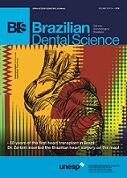Effects of intracanal medicaments and the remaining cavity wall on fracture strength of endodontically treated molars
DOI:
https://doi.org/10.14295/bds.2018.v21i1.1506Abstract
Objective: The aim of this study was to investigate the effects of the short-term intracanal application of two medicaments on the fracture strength of root-filled molar teeth with different levels of tooth structure loss. Material and Methods: Standard access cavities of totally 84 intact maxillary molar teeth were prepared in 72 teeth and were divided into 3 main groups. Standard access cavities were kept in the first group, while mesio-occlusal-distal cavities (MOD) were prepared in the second and third groups. One-half of the palatinal walls were removed in the third group. Twelve sound teeth were used in the fourth group as control. Each group was then assigned into two subgroups according to the medicament used (n=12): 2% chlorhexidine gel and calcium hydroxide. Samples were stored at 37°C and 100% humidity for 1 week. Then the teeth were inserted into a universal testing machine and vertically loaded (5 mm/min) from the occlusal surface. The data was recorded in Newtons and statistically evaluated using a Univariate ANOVA and a Tukey as post hoc test. Results: A significant difference was found among the test groups (p<0.01). No significant difference was found according to the medicament used (p>0.05), however the number of remaining walls significantly affected the fracture strength (p<0.01). The first group with access cavity showed mostly repairable fractures (60%–80%) whereas the others showed mostly non-repairable fracture patterns (60%–90%). Conclusion: In conclusion, the fracture strength of endodontically treated teeth is related to the structure loss rather than the intracanal medicament used.
Keywords
Endodontically treated teeth; Fracture strength; Intracanal medicament; Remaining cavity wall; Root facture.
Downloads
Downloads
Published
How to Cite
Issue
Section
License
Brazilian Dental Science uses the Creative Commons (CC-BY 4.0) license, thus preserving the integrity of articles in an open access environment. The journal allows the author to retain publishing rights without restrictions.
=================




























